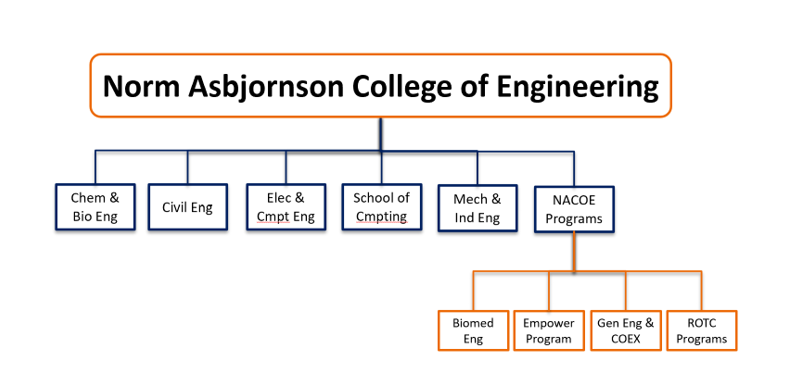ROTC Programs Structure
The NACOE houses five academic departments: Chemical & Biological Engineering, Civil Engineering, Electrical & Computer Engineering, Mechanical & Industrial Engineering, and the School of Computing. Under the heading NACOE Programs, the chart below shows programs housed at the college level. NACOE Programs includes four programs and one degree. ROTC Programs houses Army and Air Force ROTC programs.
Understanding the structure of ROTC programs is important for understanding their relationship with the University. At MSU, ROTC includes two of the four military branches: Army and Air Force. Each unit has a leader assigned to serve in this post by their respective service. The program leaders are active senior military officers and not employed by the university. This is an important characteristic because these leaders rotate into and out of position as dictated by their military service, usually two to three years. Additionally, these servicemen and women also report to a military chain of command in addition to the university.
The organizational structure below visually shows ROTC programs are divided into two (2) units and affiliated with the university through the NACOE as the parent college. Color is used to distinguish between units. Army ROTC (green) and Air Force ROTC (blue) are housed under the NACOE (orange) through ROTC programs (orange). Solid lines demonstrate direct report structures with the program leaders reporting directly to the Dean of the NACOE. In the university structure, the program lead can be compared to a department head who reports to the NACOE Dean in matters related to program affiliation. Through the university, each ROTC unit has a liaison employed by the university. While the program lead and faculty may change regularly in response to military orders, the university liaison holds the institutional, typically staying in this role for long periods of time. They are familiar with university systems and processes, have relationships across campus, and know the student cadets.
NACOE ROTC Community program creates a connection between the NACOE Dean, the Army and Air Force ROTC program leads, and university liaisons. This collaborative relationship is shown in purple with dotted lines from program leaders and university liaisons. As a defined relationship, regular engagement can strengthen relationships between the ROTC programs, the NACOE, and the broader university community. A small sample of collaborative support are facilitating academic scholarship awards, academic advising, and coordinating university reporting.
As a collaborative effort between the NACOE and ROTC programs, NACOE ROTC Community addresses challenges and needs of students pursuing a college degree and a military commission.

